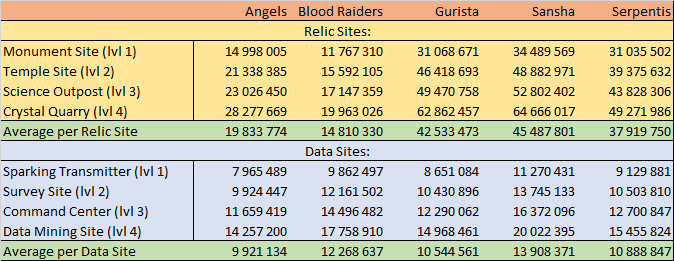Sites
| The Explorer's Handbook |
|---|
Please participate in our Exploration Adopt-A-Page Initiative and Adopt this Page!
This article is a stub. You are very welcome to expand it. Please follow our Wiki Editing Guidelines.
Overview[edit]
The system scanner shows two general types of sites: cosmic signatures and cosmic anomalies. The primary difference between the two is that cosmic signatures need to be located by probe scanning, while cosmic anomalies can be seen and warped to without the need for probes. In this portion of the guide, the various types of sites that can be found as cosmic signatures and cosmic anomalies will be discussed.
However, the distinction between cosmic signatures and cosmic anomalies based on the need for scanning isn't exceptionally useful when discussing the sites themselves, so this portion will categorize sites by their contents. To sum up which sites appear as signatures or anomalies: un-gated combat sites and ore sites are anomalies, and all of the others are signatures.
There are some predictable differences between sites located in different areas of space, but the first thing to consider is the general classification of space: high security (hisec), low security (lowsec), null security (nullsec), and wormhole space (WH or j-space). Each of these, according to conventional wisdom at least, are increasingly dangerous to fly in. Selecting sites starts with a determination of acceptable risk.
Hisec systems are generally considered safe due to the presence of CONCORD police forces, which will attack and destroy anyone who attacks another player. They might not arrive quickly enough to save the unfortunate pilot being attacked, but they will at least avenge the death. Even so, war declarations are essentially a bribe to CONCORD to ignore attacks by one corporation against another, and "suicide gankers" are willing to accept destruction if it results in sufficient profit (or sufficient laughs at someone's misfortune).
Lowsec systems aren't patrolled by CONCORD, meaning that destroying other players' ships is wide open. The only thing stopping a potential attacker is the possible threat from the target, or retribution from the target's allies or hired muscle. There are still a few restrictions in lowsec systems; notably warp bubbles that keep ships from escaping a camped gate can't be used in lowsec.
In nullsec, all bets are off, but wormhole space is generally considered more dangerous. The reason for this is that the local chat channel in a nullsec system will show any players currently in that system, but the local channel in j-space doesn't show anyone unless they talk in the chat. In nullsec you at least know if you're alone in the system, but in j-space you won't know unless you see another ship on your scanner... and if they know what they're doing, you won't.
In general, the profitability of sites increases with the level of danger, although j-space and nullsec sites are mostly equal in value. Whether it's better to see and be seen by others in the nullsec local chat, or to opt for the mutual secrecy of a wormhole system, is the subject of much debate.
edit break
Please note this is a work in progress, so many of the categories here are just an outline. If you have suggestions for categories or content, or resources to share, please edit them into the wiki in this overview section. Thanks and fly clever, - Chaz
Cosmic Signatures[edit]
Most of the interesting and profitable sites appear in the scanner as cosmic signatures. The specifics of how to "scan down" these signatures is covered in another section of this guide, but there are a few steps in the scanning process that relate to the types of sites that can be found.
When a signature is 25% scanned, the scanning window will give a category of the site being scanned: relic, data, combat (gated), gas, or wormhole. At this point it's possible to abandon scanning a site; explorers planning to hack relic and data sites won't need to spend time scanning down gas sites, for example.
When a signature is 75% scanned, the full name of the site will be given. For example, a pirate data site will have information such as the pirate faction and overall quality of the site, while a gated combat site will indicate the type and strength of enemies that can be found there.
Scanning difficulty 1, 2, 3...
Resource Sites[edit]
Some resource harvesting sites (including ores, gases, and ice) can be found in wormhole systems or as scannable cosmic signatures. Because j-space and signature scanning are important areas of interest for Signaleers, an overview these types of resource sites will be provided here. While far from a mining career guide, this should give a basic idea of what resources you might encounter in your explorations.
Remember that according to the SC Credo, your knowledge of the location of wormholes and cosmic signatures can't be provided to non-SC members. This includes resource sites: we can't tell people who want to mine in a wormhole where they can find one, or point out a scannable k-space signature to interested parties. This is the kind of Credo issue that brings up the difference between "neutral" and "nice". While it would be nice to help people out, we have to make sure that we don't compromise our neutral stance, and giving out information to specific people that isn't freely available to everyone puts us on one side or the other.
So, if you want to scan down signatures for mining or huffing by yourself or with SC Corp mates, go for it. Otherwise, keep the information to yourself.
Pirate Sites[edit]
Pirate relic and data sites can be found in all categories of space, with the pirate faction name matching the faction prevalent in that area. Wormhole systems classified as C1, C2, and C3 contain the same sites as can be found in nullsec, and can be of any faction.
Various sources will give different assessments of which pirate faction's sites are the most valuable, but as with many things in EVE the value of any particular site fluctuates based on market demand. A very rigorous analysis by Redditor MacrophageNT produced the following chart for pirate data and relic sites found in nullsec and j-space; bear in mind that the market prices are not necessarily the same now as when the chart was made (although the prices now aren't necessarily the same as last week's prices either).
You can view the entire Reddit post, although it becomes increasingly technical. The short version is that relic sites are usually much more lucrative than data sites, and that Sansha faction sites tend to be the most valuable overall.
Relic Sites[edit]
Names vary by space category
Can names by average loot value
Data Sites[edit]
Names vary by space category
Can names by average loot value
Sleeper Sites[edit]
Basic Sleeper lore
Types of rats, strengths and weaknesses
Relic and Data Sites[edit]
Unsecured and forgotten sites, C4+ sites?
Ghost Sites[edit]
Arrangement, timers
Rats
Cans and loot
Strategies for running sites
For ship fits designed to survive Ghost Site damage, please click here.
Sleeper Cache Sites[edit]
Arrangement
Rats
Cans and loot
Strategies for running sites
Gas Sites[edit]
Gas Sites[edit]
Gas sites can be found as scannable cosmic signatures in both k-space and j-space, in the form of nebulae in k-space and reservoirs in j-space. Harvesting gas in either type of site requires training the Gas Cloud Harvesting skill and equipping a gas cloud harvester module to your ship. The Venture and Prospect are popular "gas huffing" ships; training Gas Cloud Harvesting 2 and the Mining Frigate skill will allow you to fit harvesters in both high slots, and will provide bonuses to mining yield as well.
K-Space Nebulae[edit]
Nebulae are typically located in lowsec and nullsec systems, though they have occasionally been seen in hisec. These can be harvested to obtain mykoserocin and cytoserosin gases, used to create combat boosters. These gases come in eight "flavors", which affect the type of booster being made, and are typically found in predictable regions of space. For an exhaustive list of nebulae and their harvestable gases, the EVE University wiki is available.
Nullsec nebulae are significantly more dangerous than others to harvest. These nebulae can spawn aggressive pirate NPC's, based on the region of space where they are located. Also, nullsec nebulae are volatile, and have a chance of exploding whenever a gas cloud harvester module completes a cycle, dealing from 800 to 2500 damage to nearby ships. If you are planning on using two harvesters in a nullsec nebula, be sure to run them simultaneously in order to only risk one explosion per cycle instead of two.
J-Space Reservoirs[edit]
J-space gas reservoirs are sources of various fullerene gases that are used for Tech 3 industry, and can't be found anywhere else. Perimeter and Frontier Reservoirs can be found in any class system, but Core Reservoirs are only located in C5 and C6 systems.
Reservoirs will typically spawn hostile Sleepers about 15 to 20 minutes after the site is entered, at which point gas huffers need to be prepared to fight or to run away before being attacked. An important exception is the Ordinary Perimeter Reservoir, which starts off guarded by Sleepers capable of destroying a mining ship like the Venture in short order.
Chemical Labs[edit]
- TBD: https://wiki.eveuniversity.org/Combat_sites
- Note: It is displayed by the game client as a gas site. It is a mixture of multiple activities (combat, hacking).
Ore Sites[edit]
Ore sites are cosmic anomalies that contain various types of asteroids which can be mined using special equipment in order to retrieve ore and ice they contain. Both ore and ice can be reprocessed to retrieve various materials which can be used for production. Alternatively, ores, ices and reprocessed materials can be sold on market for profit (beware that demand and therefore prices may change over time).
Ore Anomalies[edit]
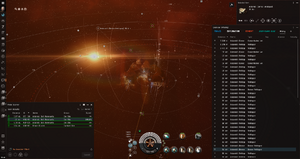
Virtually all systems in k-space have asteroid belts which can be used for mining various ores depending on a region and security status of systems containing them. Ore Anomalies work in a similar way. On wapr-in capsuleers are presented with a bunch of asteroids to mine. Just as with regular asteroid belts, these sites may be guarded by rats, so miners should be ready to deal with them in one way or another.
Unlike regular asteroid belts these anomalies also spawn in j-space systems, providing a source of minerals for capsuleers who chose to live in this harsh environment. They may contain ores which are not available in high and low security systems.
There are 2 ways to find Ore Sites. Resource Harvesting / Ore Anomalies tab in Agency window can be used to find nearby Ore Sites within k-space. Another way is to use the Probe Scanner window. These anomalies automatically appear there when a pilot enters a system, so there is no need to use scanning equipment to scan them down. However certain precautions should be taken in j-space as wormholes can be rolled unexpectedly.
Ore Anomalies in k-space are called using the following pattern: <Size> <Ore Types> Deposit. For example, Average Hedbergite, Hemorphite, and Jaspet Deposit. Size determines the amount of asteroids the anomaly contains. Ore Types determines what kind of ore can be mined there.
There is a special kind of Ore Anomalies called Asteroid Belt Remnants which can be found in new player starter systems and career agents systems. These anomalies are focused on new players and contain a lot of small Veldspar asteroids.
Yet another type of Ore Anomalies is called using the following pattern: <Size> Asteroid Cluster. For example, Medium Asteroid Cluster. These anomalies are being generated by Ore Prospecting Arrays which can be deployed in player-owned null sec systems. Such asteroid clusters (with the exception of small ones) can contain varying amounts of all null sec ore types.
Ore Anomalies in j-space are called using the following pattern: <Characteristic> <Perimeter or Frontier or Core> Deposit. For example, Isolated Core Deposit. Perimeter and Frontier sites can be found in any j-space class system, and Core ones spawn in C5, C6 and Shattered systems. Shattered systems can also have anomalies called Shattered Debris Field. All of them contain various amounts of the same set of low sec and null sec ores.
See more information here:
- https://wiki.eveuniversity.org/Category:Ore_sites provides information about the contents and yields of these sites
- https://ore.cerlestes.de/ore gives updated data on current ore and refined products prices
- https://wiki.eveuniversity.org/Mining has a lot of information about mining
Ice Belts[edit]
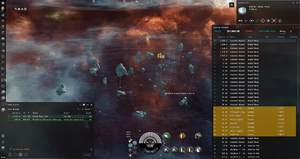
Ice Belts are Cosmic Anomalies that contain a bunch of ice asteroids which can be mined in order to harvest ice. These sites are protected by hostile NPCs which spawn in waves every 20 minutes. Similar to other activities it requires special equipment and skills, but, unlike ore mining and gas huffing, players are also required to have Omega subscription in order to train and do it.
There are 3 types of ice asteroids. Faction and Enhanced Faction ice asteroids produce small quantities of Heavy Water, Liquid Ozone, and Strontium Clathrates, but large amounts of the isotopes needed to fuel a particular faction's jump drives and POS's. Faction ice asteroids are always found within that faction's territory, while enhanced faction ice asteroids are located in a specific faction's nullsec systems or in shattered wormhole systems. The third type of ice asteroid, the standard ice asteroid, contains high amounts of Heavy Water, Liquid Ozone, and Strontium Clathrates, but no faction isotopes; these are found in lowsec and nullsec ice belts, and in Shattered Ice Fields.
Ice belts always spawn in the same systems, which can be found using Resource Harvesting / Ice Belts tab of in-game Agency window or by using external tools and websites. Since Ice Belts are Cosmic Anomalies they appear in the Probe Scanner window automatically when capsuleers enter systems containing them and don't require specialized scanning equipment to scan them down. In j-space Ice Belts can only be found in shattered systems.
Ice Belts in k-space are called using the following template: <Ice Type> Belt. For example, Smooth Glacial Mass Belt. Ice Type determines what kind of asteroids (as well as ice) the site contains. Ice Belts in j-space are called Shattered Ice Field.
One system can have 1-3 ice belts. Once all asteroids in a field are depleted it disappears and re-spawns at a different location of the system in 6 hours or directly after the downtime. Due to their comparative rarity, Ice Belt harvesting has a sense of urgency that most mining activities do not, as numerous miners descend on freshly spawned belts and try to harvest as much as possible for themselves before the ice is depleted. This concentration of mining ships makes these sites attractive to PVP hunters as well. These factors make ice mining a very different and potentially hazardous challenge.
See more information here:
- https://wiki.eveuniversity.org/Ice_harvesting contains information about ice harvesting
- https://evemaps.dotlan.net maps can be used to locate systems with ice belts (see map legends)
- https://ore.cerlestes.de/ice gives updated data on current ice and refined products prices
- https://wiki.eveuniversity.org/Mining has a lot of information about mining
Combat Sites[edit]
Combat sites can be found all over New Eden and usually involve fighting against multiple NPC ships flown by pirates or rogue drones (other players may interfear to steal rewards or impose PVP). All enemy ships within a combat site have bounties which are paid in ISK uppon their destruction and may be salvaged afterwards for some extra loot. However, most of the time the main source of profit comes from uniquely named ships which may spawn there and drop faction or deadspace modules and unique blueprint copies when destroyed.
TBD: loot
Difficulty[edit]
Combat sites vary in difficulty quite a lot depending on the security level of the area they are found in and a type of the site. While high sec anomalies may be considered entry-level combat sites and should be runnable by new players, high-level DED rated complexes found in null sec may require a good fitted fleet of several ships to run.
The easiest sites may contain a dozen or two ships mainly consisting of frigates and destroyers, with few cruisers and sentry guns. Low sec sites introduce battlecruisers and battleship, with some of the harder sites containing around 90-100 enemy ships. Null sec sites may ocassionaly spawn dreadnoughts and supercarriers, with some of the DED rated sites containing well beyond 200 ships in total. As the complexity of sites increase, the amount of EWAR, variability of reinforcement triggers and spawn of particularly strong enemies increase.
Types[edit]
Cosmic Anomalies[edit]
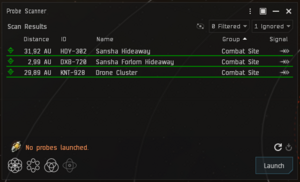
This is the simplest type of combat sites in terms of mechanics. Ships of any size are allowed to enter, there are no acceleration gates and there is only 1 grid with multiple waves of hostile ships to destroy. Once all enemies are destroyed the site is considered completed and its signature disappears.
Some combat anomalies can rarely spawn a commander ship that can drop faction loot. Also once all enemies are destroyed some combat anomalies may escalate into DED rated complexes.
These combat sites can be found using the Agency window under the Exploration / Combat Anomalies category or by simply flying from one system to another. They automatically appear in the Probe Scanner window, so no scanning equipment is required to locate them.
Pirate sites spawn only in regions designated to that pirate faction. They are named using the following pattern: <faction name> <optional variation name> <anomaly name>. For example, Guristas Hidden Hideaway. Faction name represents the pirate faction the site is related to: Angel, Blood, Guristas, Sansha or Serpentis. Anomaly name denotes relative difficulty of the site (sorted from easiest to hardest): Hideaway, Burow, Refuge, Den, Yard, Rally Point, Port, Hub, Haven and Sanctum. Some sites in addition to their basic version also have multiple variations of progressive difficulty: Hidden, Forsaken, Forlorn.
Drone combat sites can spawn in any region. They are named using the following pattern: Drone <anomaly name>. For example, Drone Cluster. Similar to pirate sites, anomaly name denotes relative difficulty of the site (sorted from easiest to hardest): Cluster, Collection, Assembly, Gathering, Surveillance, Menagerie, Herd, Squad, Patrol and Horde.
A list of combat anomalies can be found here:
- https://wiki.eveuniversity.org/Combat_sites#Anomalies
- https://wiki.eveuniversity.org/Wormhole_sites
- https://wiki.eveuniversity.org/Category:Combat_Anomalies
Besieged Covert Research Facility
This is a special type of a combat site that can be found in low security systems in any region. They spawn 2 waves of Mordu's Legion ships which are able to switch damage types in order to find what works best to destroy their target.
See more information here: https://wiki.eveuniversity.org/Besieged_Covert_Research_Facility
Faction Warfare
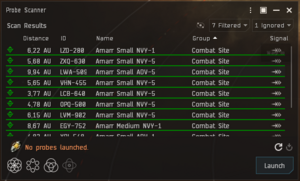
WARNING! Faction Warfare is prohibited to Signal Cartel members as it implies aggression against other capsuleers.
Faction Warfare Complexes, also known as Plexes (not to be confused with PLEX), can be found in faction warfare low security systems which can be located on the Map using Factional Warfare filters.
A complex is a small area of Deadspace that contains a warp-in beacon and a capture point. An NPC ship belonging to the faction controlling the system defends the the complex. Uppon warping to a site capsuleers are presented with acceleration gates (except Open Complexes) which will transfer them to the warp-in beacon. After lending on the grid participants have to destroy all enemy ships around the capture point and stay there until the timer counts down to 0. If an enemy ship enters the complex during this period the timer will pause until ships from only one faction are present in the complex capture radius. Once the timer reaches 0 the complex is considered to be captured and disappears.
Neutral pilots who are not active members of a militia have to go suspect in order to enter these sites and can't capture complexes.
Names of factional warfare complexes are formed as: <faction name> <size> <type> <limit>. Faction name indicates the faction who owns the system. Size determines which ship sizes are allowed in, capture times and what kind of ships will the NPC defenders fly. Size can be one of: Scout, Small, Medium, Large or Open. Type determines what kind of ships can enter the site. Type can be either NVY allowing only T1 and Navy ships, or ADV allowing T2, T3, SoCT, Triglavian and Pirate Faction ships. Limit indicates the number of characters the site reward scales to before reducing loyalty point payout, either 1 or 5. For example, Amarr Medium NVY-5 would indicate a site in an amarr-owned system where the rewards scale to 5 capsuleers, and Tech 1 or Navy ships of size Cruiser or smaller are allowed inside.
See more information here: https://wiki.eveuniversity.org/Faction_warfare
Triglavian Invasion Combat Sites
There is a number of combat sites related to Triglavian Invasion which feature NPCs from Triglavian Collective and EDENCOM. They can be found in systems invaded by Triglavian Collective (with different sites spawning depending on the current phase) and Pochven.
EDENCOM sites include EDENCOM Forward Post, EDENCOM Staging Area, EDENCOM Field Base and Observatory Flashpoint. Clearing these sites will help Triglavian Collective.
Triglavian sites include Emerging Conduit, Minor Conduit, Major Conduit and Stellar Fleet Deployment Site. Clearing these sites will help EDENCOM.
There are also Rogue Drone sites in Pochven called Incipient Drone Swarm that can be used to raise standings for both Triglavians and EDENCOM.
See more information here:
- https://wiki.eveuniversity.org/Triglavian_Invasion_combat_sites
- https://wiki.eveuniversity.org/Pochven#Combat_sites_in_Pochven
TODO:
- Analyze https://pochven.electusmatari.com/
- Analyze https://wiki.signalcartel.space/SCA:Educational_Resource_Archive#.F0.9F.94.96_Pochven
Cosmic Signatures[edit]
This type of combat sites differ from anomalies in a way that they have to be scanned down using a probe launcher equipped with scanner probes. It is also considered to be both more dangerous and more rewarding.
Unrated complexes
Unrated complexes are built of several deadspace rooms separated by acceleration gates. Uppon entering every room has an initial wave of hostile ships defending it. These ships may be split into multiple groups spread out throughout the system. Additional waves may be spawned due to triggering certain site-specific events like a certain amount of time passing, destruction of a specific ship, approaching a specific structure, etc. Acceleration gates separating rooms are usually locked, in which case some condition must be fulfilled, or a key must be found to proceed.
Most of pirate sites are named using the following pattern: <faction name> <complex name> with an expection of Provisional <faction name> Outpost and Minor <faction name> Annex. Faction name determines a pirate faction there sites belong to: Angel, Blood, Guristas, Sansha and Serpentis. Complex names differentiate the sites: Hideout, Lookout, Watch, Vigil, Provisional Outpost, Outpost, Minor Annex, Annex, Base, Fortress, Military Complex, Provincial HQ and Fleet Staging Point.
There is also a much harder version of Dark Blood Fleet Staging Point site called Blood Raider Temple Complex, which requires several people in well-tanked ships.
Drone sites don't follow any particular pattern: Haunted Yard, Desolate Site, Chemical Yard, Rogue Trial Yard, Dirty Site, Ruins, Independence, Radiance, Hierarchy.
Unrated complexes may escalate into expeditions.
See more information here: https://wiki.eveuniversity.org/Combat_sites#Unrated_complexes
DED rated sites
DED rated complexes are cosmic signatures which have been rated on a difficulty scale from 1 to 10 by CONCORD's Directive Enforcement Department. Higher rating sites contain stronger enemies. Rating also determines maximum size of ships which can enter these sites. Starting from frigates at level 1/10, the ship size goes up by one size category with each increase in rating, maxing out at battleships at level 5/10.
Structure of DED rated sites is similar to unrated complexes, but there are some differences:
- There are no extra waves. All enemy ships begin on-grid in each room.
- Many DED rated complexes have locked gates which can be unlocked by a certain trigger. This makes blitzing possible, as it is not required to destroy all enemy ships.
- These sites always spawn at least one overseer structure or ship that can drop deadspace modules, pirate ship BPCs or faction modules.
DED rated complexes do not escalate. But pilots may get an escalation if the site itself was received as an escalation from an anomaly. In this case the escalation will be the same as the "original" DED rated site.
Every DED rated site has a unique name that doesn't follow any pattern. Use a list of DED rated sites to identify one.
See more information here: https://wiki.eveuniversity.org/Combat_sites#DED_rated_complexes
Expeditions[edit]
Expeditions are chains of multiple combat sites tied with a plot which pilots may get as an escalation while running unrated complexes. Most of them may consist of up to 4 sites. But it is not guaranteed that all of them will happen every time, because when a site is complete there is only a 50% chance that it'll escalate into the next one.
These sites are located in different systems which are usually several jumps away one from another. Even though the locations are random, the fourth site may spawn in a lower security space then the one the expedition has started in.
The actual sites usually have 2 rooms separated by an acceleration gates. Some acceleration gates may have restrictions on a size of a ship that can fly though them. Rooms may spawn several waves of hostile ships which may be separated in several groups. Although it is not always required to destroy all of them as there may be different triggers for the next site to escalate (like destroying a particular ship or using the acceleration gate).
Beware that even expeditions spawned in high security space may feature enemies up to the size of battleships.
Expedition sites can't be scanned down using probe scanner. The information about them can be found in The Agency. However, some of these sites are just open grids, which makes people running them vulnerable to combat scanners.
See more information here: https://wiki.eveuniversity.org/Combat_sites#Expeditions
COSMOS[edit]
COSMOS combat sites are connected with COSMOS missions. They provide reward items which may be needed for COSMOS missions, materials for building storyline modules, faction modules and some rare items. Unlike COSMOS missions these sites can be entered at any time and re-spawn after completion. However, some of them may have restrictions on the maximum ship size that can enter acceleration gates or require items which may be provided by COSMOS agents, found in containers, etc.
Usually they consist of multiple rooms which may contain enemy ships which may be split into multiple groups sometimes. However, different sites vary a lot. Some rooms may contain COSMOS agents, some enemy ships may be passive unless you approach or attack them, some rooms may even have no defenders at all. Beware that enemy ships may respawn over time and potentially cause issues if you're unable to destroy them quick enough.
COSMOS sites can be located using the Star Map and the "DED deadspace reports". These sites always respawn at the same location. Some of them may be shown in the Overview as warpable beacons, some are cosmic signatures which have to be scanned down.
Beware not to confuse COSMOS sites with COSMOS missions. Unlike sites COSMOS missions can only be ran once, so it is adviced to prepare ahead of time and avoid talking to COSMOS agents unless you are sure that you can run a certain mission.
See more information here:
- https://wiki.eveuniversity.org/COSMOS
- https://wiki.eveuniversity.org/Amarr_COSMOS
- https://wiki.eveuniversity.org/Caldari_COSMOS
- https://wiki.eveuniversity.org/Gallente_COSMOS
- https://wiki.eveuniversity.org/Minmatar_COSMOS
- https://wiki.eveuniversity.org/Angel_COSMOS
- https://wiki.eveuniversity.org/Blood_Raider_COSMOS
- https://wiki.eveuniversity.org/Guristas_COSMOS
- https://wiki.eveuniversity.org/Serpentis_COSMOS
Strategies[edit]
Combat sites come in all sorts and varieties, so it is impossible to come up with a single strategy that'll suit every single one of them. However, there are several principles which may be used in most cases.
Most of combat sites are pretty predictable. Usually the location of a site dictates what enemy ships it'll feature. Sites found in Gurista inhabited space will spawn Gurista pirates and so on. Different factions have certain prefferences when it comes to fitting their ships, which makes it possible to predict what kind of damage they're going to deal, what type of E-WAR they're going to use and what type of damage they can resist. It makes is possible to fit your ship accordingly, so that it can withstand damage dealt by enemies while hitting them hard at the same time. Such specialization may significantly speed up destruction of enemy ships, but it also makes you more vulnerable to gankers.
Depending on the site, your goals, skills and fit there may be different strategies to run it. It is may be worth to learn specifics of the site ahead of time. Sometimes it may be possible to blitz it by cherry-picking particular ships in order to get an escalation quicker, or to get to the next room quicker, or to prevent the site from being stolen by other capsuleers, etc. Sometimes it may be important to pay attention to what targets to destroy first as some ships may spawn reinforement waves or deal much more damage then others do.
TBD: recommended fits or fleets
The following resources may come in handy:
- NPC damage types
- EVE University wiki contain a lot of information about combat sites. Sections describing various combat site types contain a bunch of links leading there. While a lot of sites are described pretty good, some are not. So it may be needed to search for other resources.
- YouTube videos may be a valuable source of information on how to run a particular site
- Websites like EVE Ref may be used to see information about capabilities of enemy ships
- Websites like EVE Workbench and zKillboard may be used to fit a ship
- Websites like DOTLAN EveMaps may be used to plan your route
Abyssal Deadspace[edit]
TBD: https://wiki.eveuniversity.org/Abyssal_Deadspace TODO: Mention that PvP Abyssal arenas are prohibited for SC pilots
Homefront Operations[edit]
TBD: https://forum.eveuniversity.org/viewtopic.php?t=126552
Warping To / Moving In Sites (temp title)[edit]
Perches strategy, "on grid"-ness
Cloaking near objects
Alignment
Slow boating, MWD, AB movement
Safe distances for warping and hacking
Object obstructions
D-scan use for checking sites?
Respawn Timers[edit]
Respawn of rats
Respawn of Cans or sites
Ghost site timer resetting and respawn
Respawn good citizenship
